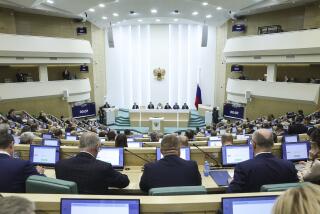Joint U.S.-Soviet Nuclear Tests to Aid in Verification
- Share via
GENEVA — The United States and the Soviet Union have agreed to carry out several joint nuclear test explosions next year to calibrate equipment to help verify compliance with any future pacts on atomic blasts, a U.S. official said on Friday.
The tests would be the first such joint explosions in the nuclear age, which began in 1945. The announcement came less than three weeks before the superpowers are due to sign an accord in Washington scrapping ground-launched medium-range missiles.
Assistant Secretary of Defense Robert B. Barker, head of the U.S. team negotiating with the Soviet Union on limiting nuclear tests, told a news conference that each side will visit the other’s nuclear test sites in January to familiarize themselves with the areas.
The joint test explosions would come five or six months later and would be aimed at calibrating the monitoring equipment, he said.
Barker was speaking after the close on Friday of two weeks of talks with a Soviet team headed by Igor Palenykh.
The two-week round followed a decision in mid-September by Secretary of State George P. Shultz and Soviet Foreign Minister Eduard A. Shevardnadze to resume nuclear testing talks for the first time in seven years.
They agreed to start stage-by-stage negotiations, first reworking two unratified treaties from the 1970s that limit the size of nuclear tests to 150 kilotons, the equivalent of 150,000 tons of TNT.
They will then negotiate further limits on the size and number of blasts, and ultimately will seek to halt all atomic tests. These are most often used to check on the reliability of nuclear arsenals and to develop new weapons.
Barker said he is proud of the amount of work accomplished in the opening round. The second round would begin shortly after the exchange visits to the superpower test sites. This meant in late January or early February, he said.
In the initial joint tests, the Americans will show at the Soviet Semipalatinsk test site in Central Asia their preferred method of monitoring the size of atomic blasts, called CORRTEX, Barker said.
Soviet Monitoring System
The Soviets, during joint atomic experiments at the U.S. nuclear test site in Nevada, will try to prove the accuracy of their preferred monitoring method, which counts seismic units such as those used in monitoring earthquakes.
One essential difference is that in the American method an electrical cable must be placed within 10 or 15 yards of the blast. In the Soviet method, the earth’s tremors are monitored from many miles away.
Barker said the initial agreement was for one or two atomic blasts at each site. The final decision would be taken when the negotiators meet to design the joint nuclear test experiments.
“Only when we’ve sat down to design the experiments will we know if one or two is enough,” he said.
Barker said if the Soviet Union would accept CORRTEX monitoring methods, then the two unratified treaties could be amended and submitted to the Senate for ratification within six months.
Limits in Treaties
The 1974 Threshold Test Ban Treaty and the 1976 Peaceful Nuclear Explosions Treaty set limits on the size, or yield, of tests.
Although unratified, both superpowers have agreed to stay under the 150-kiloton ceiling but occasionally charge the other side with cheating.
The United States, the Soviet Union and Britain signed a limited nuclear test ban treaty in 1963, which stopped nuclear explosions in air, space or sea, but underground tests continued.
All five known nuclear weapon states--the United States, the Soviet Union, Britain, France and China--have carried out nuclear tests this year.
The United States has set off at least 12 test explosions this year. The Soviet Union has detonated at least 10 blasts since ending a unilateral test moratorium on Feb. 26.
More to Read
Sign up for Essential California
The most important California stories and recommendations in your inbox every morning.
You may occasionally receive promotional content from the Los Angeles Times.













